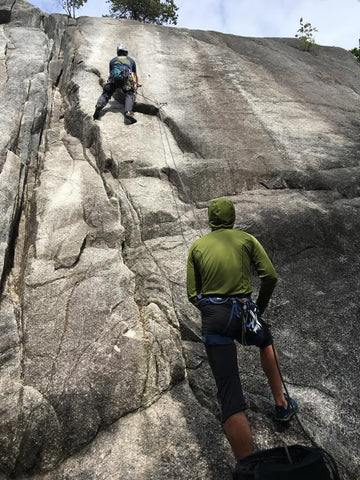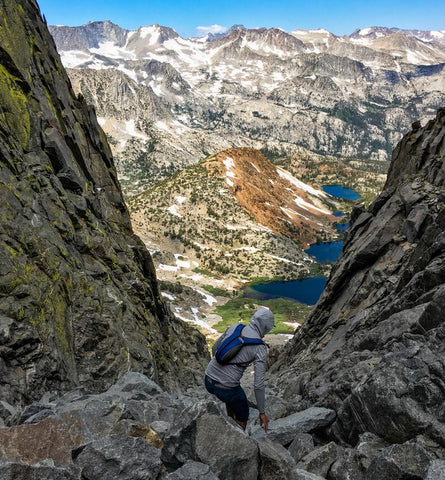
Outdoor Research Echo Hoodie Review
After years spent playing outside on California’s sun-drenched trails, beaches, and highways, it took a serious sunburn on a near-nuclear day in Utah’s Indian Creek to get me to consider a sun shirt. Roping up at the base of South Six Shooter, I did a familiar ritual: slather on a triple dose of high-SPF sunscreen in the hopes that I could leave the bottle at the base of the wall and not deal with re-applying on route. I’ve always thought this was the Achilles’ heal of sunblock: the more you sweat on a long Sierra trail run, alpine climb, or bike ride, the faster your sunblock wicks away, and the more often you need to stop and re-up. For this climb, my partner mostly skipped the sunblock, opting instead to pull up the hood on his new sun shirt, which I thought looked a little silly, especially as the temps rose. Hours later he was happy and comfortable, while I was fully baked, fully fed up with sunblock, and ready to try any alternative.

So what’s up with sun shirts? It’s probably true that any fabric provides some degree of protection from the sun’s rays, but a key element of true sun shirts is that they’re tested to confirm their sun-shielding performance (this is the Ultraviolet Protection Factor, or UPF rating). In addition, since they’re intended for use in the sun, well-designed sun shirts will be ventilated and breathable, promoting evaporative cooling and minimizing insulation. This was the real revelation for me: even though it looks like you’re wearing a sweater in 100+ deg weather, a highly breathable sun shirt keeps you pretty much just as cool as going shirtless, and it’s way, way better than a cotton T-shirt.
Since most outdoor brands have a comparable version of UPF-rated, breathable fabric, the differences between sun shirts really come down to fit and finish. Over the past year, I’ve tried the Marmot Sunrift Hoodie, the North Face Hyperlayer Hoodie, and the OR Echo Hoodie. If you’re strictly against the hood, all of these products come in hood-less shirt varieties, but be aware that you’re sacrificing a lot of really valuable sun protection for your neck, ears, and face, some of the most exposed and frequently burned areas. I’ve put these shirts through the ringer on trail runs, climbs, and rides in three different countries, across most of the western US, and of course around Bishop and Mammoth. My favorite of the bunch has been the Echo Hoodie from Outdoor Research, which wins purely on it technical features and not on looks, because this thing looks downright ridiculous--like seriously bad enough that you are going to want to strip it off before you snap that triumphant selfie on the summit, and then put it back on for the rappels.

I found that for the Echo Hoodie, OR really dialed in the fit better than most of the competitors. A sun shirt shouldn’t be too tight, or else you’ll feel suffocated. A loose fit improves ventilation, but the extra fabric can get caught up in your harness and generally gets in the way. The Echo Hoodie strikes a nice balance, with a loose enough fit to provide breathability and range of motion, but not too baggy. The fabric also feels a little thinner than other shirts, which reminds you that the hoodie is going to help keep you cool, not overheat. The hood has a close fit around the face and head, which (a) really seals out sun exposure on your upper body and (b) secures the hood in place while you’re running or going face first into the wind. The close fit means that you'll need to wear a climbing or biking helmet over the hood (if you want the reverse, a hood that will fit over a helmet, check out Marmot's Sunrift Hoodie). Dylan’s pro-tip: pair the Echo with a visor to keep the sun off your face without overheating your head.

One of the trademarks of the Echo Hoodie has been the pockets of material around the cuffs, which when reversed over your fingers create a built-in mitten to protect your hands from the sun. I loved the idea when I first saw it, but in practice it just isn’t that useful. You can’t climb or belay properly with the mittens, nor can you ride a bike. You might want to use them while trail running, but I found that since your hands are such an important point for body heat dissipation, the mittens feel like they’re trapping too much heat. Bottom-line: if you’re taking it easy and don’t need much dexterity, turn the mittens on and protect your hands. The upshot is that the additional material around your wrist isn’t noticeable, so the mittens won’t bug you even if you never use them. Another potential drawback here is that the cuffs make it difficult to push the sleeves up to your elbows, which would feel nice but defeats the sun protection.
As with many pieces of outdoor gear, the Echo Hoodie is susceptible to bad odor after absorbing sweat. This can get especially bad over multi-day trips, so plan ahead to give the shirt a rinse at camp once the sun dips. Luckily, the fabric dries fast so it’s ready again soon after washing.
All told, the Echo Hoodie gets high marks for fit and function, making it perfect for running, fastpacking, alpine missions and any high exertion activity in warm weather and full sun. If your mission is a picnic, barbecue, or hanging out at the artesians, all I can say is that it looks better than a sunburn, so maybe try another brand’s sun shirt for social occasions.
Check out the Men's and Women's Echo Hoodies from Sage to Summit.
